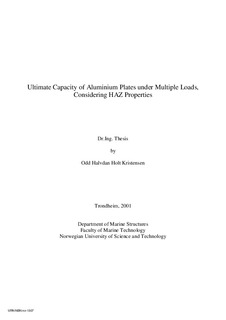| dc.contributor.author | Kristensen, Odd Halvdan Holt | nb_NO |
| dc.date.accessioned | 2014-12-19T11:24:56Z | |
| dc.date.available | 2014-12-19T11:24:56Z | |
| dc.date.created | 2001-08-10 | nb_NO |
| dc.date.issued | 2001 | nb_NO |
| dc.identifier | 125673 | nb_NO |
| dc.identifier.isbn | 82-471-5318-1 | nb_NO |
| dc.identifier.uri | http://hdl.handle.net/11250/231268 | |
| dc.description.abstract | The purpose of this work has been to investigate the ultimate capacities of aluminium plates. The aluminium plates are supposed to be part of a marine structure. Their behaviour has been explored by taking advantage of non-linear finite element simulations. The loading conditions included axial compression, transverse compression, pure shear loading, axial compression in combination with transverse compression and axial compression in combination with shear loading.
Different patterns of heat affected zones have been studied with particular attention on conventionally welded plates and extruded, welded plates. The plates have been given realistic boundary conditions in addition to boundary conditions believed to represent the extremities in plate collapse behaviour. The initial deflection patterns chosen, were generally conservative, and the variations in collapse capacities for different initial deflection patterns have been investigated. The initial deflection amplitudes were systematically varied to cover all values of the initial deflection amplitudes likely to occur.
In addition to studying different patterns of the heat affected zones, systematic variations of the breadths of the heat affected zones have been performed. Systematic variations in the magnitudes of the residual stresses and systematic variations of the reductions of the 0.2 percent tensile proof stresses in the heat affected zones have also been carried out. Three different aluminium alloys were studied. They were believed to represent a high, medium and low utilised aluminium alloy. The aspect ratio of the plates was varied to cover both plates that were completely square to plates with a length equal to five times the breadth of the plates.
It was found that axially loaded plates with heat affected zones along loaded edges had lower ultimate capacities than plates with heat affected zones along unloaded edges, and if the plates had heat affected zones along loaded edges, having additional heat affected zones along unloaded edges did not alter the buckling capacities. The reduction in ultimate capacity could be modelled to vary linearly with the breadth of the heat affected zones, and the reduction in ultimate capacity could be modelled to vary linearly with the relationship between the value of the 0.2 percent tensile proof stress in the heat affected zones and the 0.2 percent tensile proof stress of the base material.
The ultimate capacities of transversally loaded plates could be found as the sum of a square plate and a plate strip, even if the plates contained heat affected zones. Square plates and plate strips with relevant patterns of heat affected zones had to be employed. Biaxial interaction curves showed a considerable slenderness dependence for all values of the aspect ratio investigated. The biaxial interaction curves were only slightly affected by introduction of different patterns of heat affected zones. The stress corresponding to equal elastic and plastic strain was better suited as the normalising stress than the more commonly used 0.2 percent tensile proof stress. One design curve could be used to represent all the different aluminium alloys investigated. Changing the aluminium alloy did not change the shape of the biaxial interaction curves.
Based on the detailed study of the collapse behaviour of aluminium plates carried out, and established practice, new ULS design formulas for axial compression, transverse compression, pure shear loading, axial compression in combination with transverse compression and axial compression in combination with shear loading were proposed. The new design formulas accounted for reductions in ultimate capacities due to heat affected zones, including heat affected zones along loaded edges. They took full advantage of non-linear residual strength for slender plates; and the slenderness dependence and aspect ratio dependence for biaxial interaction curves were systematically incorporated. | nb_NO |
| dc.language | eng | nb_NO |
| dc.publisher | Fakultet for ingeniørvitenskap og teknologi | nb_NO |
| dc.relation.ispartofseries | Dr.ingeniøravhandling, 0809-103X; 2001:56 | nb_NO |
| dc.title | Ultimate capacity of aluminium plates under multiple loads, considering HAZ properties | nb_NO |
| dc.type | Doctoral thesis | nb_NO |
| dc.source.pagenumber | 249 | nb_NO |
| dc.contributor.department | Norges teknisk-naturvitenskapelige universitet, Fakultet for ingeniørvitenskap og teknologi | nb_NO |
| dc.description.degree | dr.ing. | nb_NO |
| dc.description.degree | dr.ing. | en_GB |
